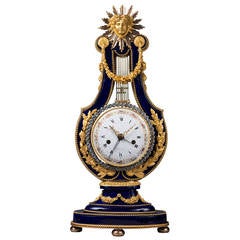Late 18th Century Porcelain
233
to
10
112
101
233
233
233
68
27
16
12
11
3
2
2
1
684
2,466
3,900
949
1,045
1,394
862
156
74
232
250
112
203
358
273
277
69
231
227
10
3
3
184
105
88
33
33
16
15
9
7
5
Period: Late 18th Century
Sèvres Porcelain Louis XVI Lyre Mantel Clock by Kinable, Dial by Dubuisson
Located in Paris, FR
Dieudonné Kinable
Enamel Dial Attributed to Dubuisson (1731-1815)
Exceptional Porcelain Lyre Mantel Clock from the Royal Sèvres Porcelain Manufactory
Paris, late Louis XVI period, circa 1785-1790
Height 62 cm; width 26 cm; depth 16 cm
The round enamel dial, signed “Kinable”, indicates the hours in Roman numerals, the fifteen-minute intervals in Arabic numerals, the annual calendar and the signs of the Zodiac, by means of four hands, two of which are made of pierced gilt bronze, the two others in blued steel. The magnificent lyre-shaped case is made of “bleu nouveau” Sèvres porcelain and finely chased and gilt bronze. The bezel is made up of a gilt bronze twisted rope; the pendulum is adorned with brilliant-cut paste stones; the body of the lyre is adorned with gilt bronze beading and with laurel leaf and seed motifs, with two rosettes issuing floral and foliate swags. The clock is surmounted by a mask with radiating sunrays. The spreading foot is decorated with beading and twisted rope motifs and a leafy garland. The en-suite decorated oval base is raised upon four flattened ball feet.
The Royal Sèvres Porcelain Factory produced the lyre clock model as of 1785. Four colours were offered: turquoise, green, pink and bleu nouveau. These exceptional clocks were made for the connoisseurs of the time. Louis XVI had a similar clock in his Salon des jeux in Versailles; its dial bore the signature of the clockmaker Courieult (this is almost certainly the example illustrated in P. Verlet, Les bronzes dorés français du XVIIIe siècle, Paris, 1999, p. 41). Kinable, however, was the clockmaker who purchased the greatest number of lyre cases from the factory, and he developed the model in the late 18th century. Among the porcelain lyre clocks signed by this brilliant horologer, one example is in the Victoria & Albert Museum in London (illustrated in H. Ottomeyer and P. Pröschel, Vergoldete Bronzen, Band I, Munich, 1986, p. 252, fig. 4.6.26). A second such clock is in the Royal British Collection (see C. Jagger, Royal Clocks, The British Monarchy & its Timekeepers 1300-1900, 1983, p. 130, fig. 176).
Bibliography:
M. Gay and A. Lemaire, “Les pendules lyre”, in Bulletin de l’Association nationale des Collectionneurs et Amateurs d’Horlogerie ancienne, Winter 1993, n° 68, p. 5-40.
Dieudonné Kinable (active circa 1785-1810)
One of the most important Parisian clockmakers of the late 18th century. His shop was located at n° 131 Palais Royal. He purchased a great number of lyre-type porcelain clock cases...
Category
French Louis XVI Antique Late 18th Century Porcelain
Materials
Bronze
Recently Viewed
View AllMore Ways To Browse
Versailles Porcelain
English Porcelain Cup
English Porcelain Cups
Versaille Porcelain
Victorian China Porcelain
Worcester Porcelain Flowers
Antique Police
Blue Royal Cobalt Porcelain
Japanese Export Silver
Rococo Porcelain Plate
18th Century Worcester Porcelain
Antique Chinese Porcelain Cups And Saucers
Blue Butterfly Plate
Chelsea Painted Furniture
Gold Heart Decor
Hunting Porcelain
Royal Vienna Set
Soup Cup
